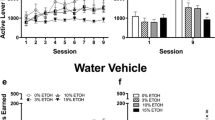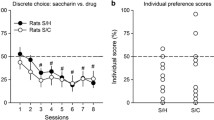Abstract
Rationale
Many theories of addictive behavior propose that cues signaling drug administration influence the likelihood of drug-taking and drug-seeking behavior.
Objectives
We investigated the behavioral impact of cues associated with unsweetened ethanol and their interaction with responding maintained by ethanol self-administration. Our goal was to establish the influence of such cues on ethanol seeking.
Materials and methods
The experiment used a matching contingency and saccharin-fading procedure to establish equal levels of responding to two spatially distinct levers using unsweetened 10% ethanol solution. After ethanol self-administration was established, a brief cue light located alternately over each lever location was either paired or unpaired (control) with the opportunity to consume the same ethanol solution. Finally, self-administration was re-established, and the effect of the cue was measured in a transfer design.
Results
The reaction to lights paired with the opportunity to ingest unsweetened ethanol had three main effects: (1) induction of operant behavior reinforced by ethanol, (2) stimulation of ethanol-seeking behavior (drinker entries), and (3) cue-directed approach and contact behavior (i.e. autoshaping or sign-tracking). Cue-directed behavior to the light interacted with choice behavior in a manner predicted by the location of the cue light, enhancing responding only when the approach response did not interfere with the operant response.
Conclusions
These findings replicate and extend the effects of Pavlovian conditioning on ethanol-seeking and support-conditioned incentive theories of addictive behavior. Signals for ethanol influence spatial choice behavior and may be relevant to attentional bias shown to alcohol-associated stimuli in humans.




Similar content being viewed by others
References
Bienkowski P, Koros E, Kostowski W, Bogucka-Bonikowska A (2000) Reinstatement of ethanol seeking in rats: behavioral analysis. Pharmacol Biochem Behav 66:123–128
Corbit LH, Janak PH (2007) Ethanol-associated cues produce general Pavlovian-instrumental transfer. Alcohol Clin Exp Res 31:766–774
Cunningham CL (1994) Modulation of ethanol reinforcement by conditioned hyperthermia. Psychopharmacology 115:79–85
Cunningham CL, Patel P (2007) Rapid induction of Pavlovian approach to an ethanol-paired visual cue in mice. Psychopharmacology 192:231–241
Czachowski CL, Santini LA, Legg BH, Samson HH (2002) Separate measures of ethanol seeking and drinking in the rat: effects of remoxipride. Alcohol 28:39–46
de Wit H, Stewart J (1981) Reinstatement of cocaine-reinforced responding in the rat. Psychopharmacology 75:134–143
Everitt BJ, Dickinson A, Robbins TW (2001) The neuropsychological basis of addictive behaviour. Brain Res Rev 36:129–138
Field M, Eastwood B (2005) Experimental manipulation of attentional bias increases the motivation to drink alcohol. Psychopharmacology 183:350–357
Field M, Mogg K, Zetteler J, Bradley BP (2004) Attentional biases for alcohol cues in heavy and light social drinkers: the roles of initial orienting and maintained attention. Psychopharmacology 176:88–93
Glasner SV (2004) Motivation and addiction: the role of incentive motivation in understanding and treating addictive disorders. In: Cox WM, Klinger E (eds) Handbook of motivational counseling: concepts, approaches, and assessment. Wiley, New York, pp 29–47
Glasner SV, Overmier JB, Balleine BW (2005) The role of Pavlovian cues in alcohol seeking in dependent and nondependent rats. J Stud Alcohol 66:53–61
Kampov-Polevoy AB, Overstreet DH, Rezvani AH, Janowsky DS (1995) Suppression of ethanol intake in alcohol-preferring rats by prior voluntary saccharin consumption. Pharmacol Biochem Behav 52:59–64
Karpicke J (1978) Directed approach responses and positive conditioned suppression in the rat. Anim Learn Behav 6:216–224
Karpicke J, Christoph G, Peterson G, Hearst E (1977) Signal location and positive versus negative conditioned suppression in the rat. J Exp Psychol Anim Behav Processes 3:105–118
Katner SN, Weiss F (1999) Ethanol-associated olfactory stimuli reinstate ethanol-seeking behavior after extinction and modify extracellular dopamine levels in the nucleus accumbens. Alcohol Clin Exp Res 23:1751–1760
Katner SN, Magalong JG, Weiss F (1999) Reinstatement of alcohol-seeking behavior by drug-associated discriminative stimuli after prolonged extinction in the rat. Neuropsychopharmacology 20:470–479
Krank MD (1989) Environmental signals for ethanol enhance free-choice ethanol consumption. Behav Neurosci 103(2):365–372
Krank MD (2003) Pavlovian conditioning with ethanol: sign-tracking (autoshaping), conditioned incentive, and ethanol self-administration. Alcohol Clin Exp Res 27:1592–1598
Krank MD, O’Neill S (2002) Environmental context conditioning with ethanol reduces the aversive effects of ethanol in the acquisition of self-administration in rats. Psychopharmacology 159:258–265
Krank MD, Wall A (1990) Cue exposure during a period of abstinence reduces the resumption of operant behavior for oral ethanol reinforcement. Behav Neurosci 104(5):725–733
Kruzich PJ, Congelton KM, See RE (2001) Conditioned reinstatement of drug-seeking behavior with a discrete compound stimulus classically conditioned with intravenous cocaine. Behav Neurosci 115:1086–1092
Lajoie J, Bindra D (1976) An interpretation of autoshaping and related phenomena in terms of stimulus-incentive contingencies alone. Can J Psychol 30:157–173
Liu X, Weiss F (2002) Additive effect of stress and drug cues on reinstatement of ethanol seeking: exacerbation by history of dependence and role of concurrent activation of corticotropin-releasing factor and opioid mechanisms. J Neurosci 22:7856–7861
Liu X, Caggiula AR, Yee SK, Nobuta H, Poland RE, Pechnick RN (2006) Reinstatement of nicotine-seeking behavior by drug-associated stimuli after extinction in rats. Psychopharmacology 184:417–425
Marissen MAE, Franken IHA, Waters AJ, Blanken P, van den Brink W, Hendriks VM (2006) Attentional bias predicts heroin relapse following treatment. Addiction 101:1306–1312
Markou A, Weiss F, Gold LH, Caine SB (1993) Animal models of drug craving. Psychopharmacology 112:163–182
Matthews DB, Overstreet DH, Rezvani AH, Devaud LL, Morrow AL (2001) Effects of sweetened ethanol solutions on ethanol self-administration and blood ethanol levels. Pharmacol Biochem Behav 68:13–21
Meil WM, See RE (1996) Conditioned cued recovery of responding following prolonged withdrawal from self-administered cocaine in rats: an animal model of relapse. Behav Pharmacol 7:754–763
Orford J (2001) Addiction as excessive appetite. Addiction 96:15–31
Panlilio LV, Weiss SJ, Schindler CW (2000) Effects of compounding drug-related stimuli: escalation of heroin self-administration. J Exp Anal Behav 73:211–224
Ranaldi R, Roberts DCS (1996) Initiation, maintenance and extinction of cocaine self-administration with and without conditioned reward. Psychopharmacology 128:89–96
Robbins TW, Everitt BJ (1999) Interaction of the dopaminergic system with mechanisms of associative learning and cognition: implications for drug abuse. Psychol Sci 10:199–202
Robinson TE, Berridge KC (2004) Incentive-sensitization and drug ‘wanting’. Psychopharmacology 171:352–353
Samson HH, Tolliver GA, Lumeng L, Li T (1989) Ethanol reinforcement in the alcohol nonpreferring rat: initiation using behavioral techniques without food restriction. Alcohol Clin Exp Res 13:378–385
Stewart J (1983) Conditioned and unconditioned drug effects in relapse to opiate and stimulant drug self-administration. Prog Neuro-Psychopharmacol Biol Psychiatry 7:591–597
Tomie A, Wong K, Apor K, Patterson-Buckendahl P, Pohorecky LA, Jerrells TR (2003) Autoshaping of ethanol drinking in rats: effects of ethanol concentration and trial spacing. Alcohol 31:125–135
Tsiang MT, Janak PH (2006) Alcohol seeking in C57BL/6 mice induced by conditioned cues and contexts in the extinction-reinstatement model. Alcohol 38:81–88
Uslaner JM, Acerbo MJ, Jones SA, Robinson TE (2006) The attribution of incentive salience to a stimulus that signals an intravenous injection of cocaine. Behav Brain Res 169:320–324
Weerts EM, Goodwin AK, Kaminski BJ, Heinz RD (2006) Environmental cues, alcohol seeking, and consumption in baboons: effect of response requirement and duration of alcohol abstinence. Alcohol Clin Exp Res 30:2026–2036
Wise RA (2002) Addiction. In: Pashler H, Gallistel R (eds) Steven’s handbook of experimental psychology, vol. 3: Learning, motivation, and emotion, 3rd edn. Wiley, New York, pp 801–840
Zironi I, Burattini C, Aicardi G, Janak PH (2006) Context is a trigger for relapse to alcohol. Behav Brain Res 167:150–155
Acknowledgments
We would like to thank Lisa Brake, Tracy Estabrooks, Elaine Hounsell, and Patricia MacCullum for their assistance in the collection and analysis of data described here. This research was supported by a grant from the National Science and Engineering Research Council of Canada to Marvin D. Krank.
Author information
Authors and Affiliations
Corresponding author
Rights and permissions
About this article
Cite this article
Krank, M.D., O’Neill, S., Squarey, K. et al. Goal- and signal-directed incentive: conditioned approach, seeking, and consumption established with unsweetened alcohol in rats. Psychopharmacology 196, 397–405 (2008). https://doi.org/10.1007/s00213-007-0971-0
Received:
Accepted:
Published:
Issue Date:
DOI: https://doi.org/10.1007/s00213-007-0971-0




